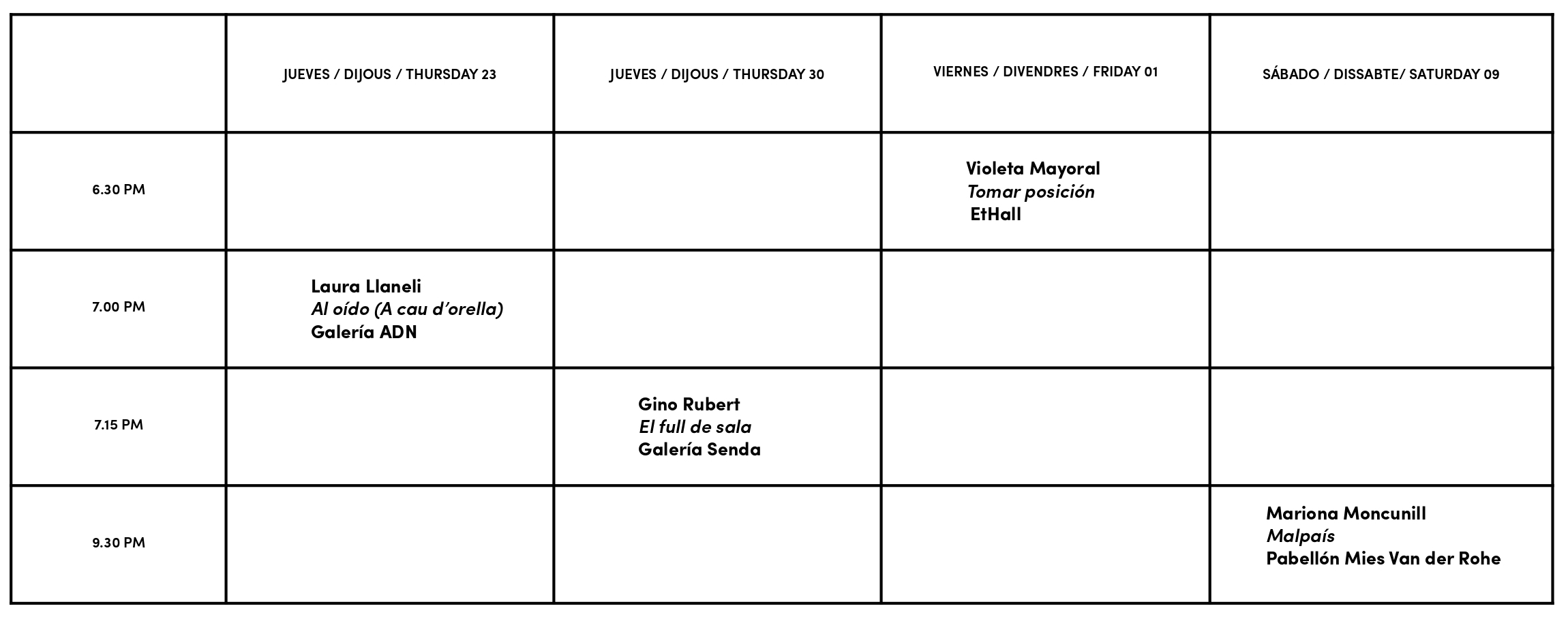The Terror of Total Dasein. Economies of Presence in the Art Field
Curated by Gisela Chillida.
The cycle of performances seeks to (re)think the idea of “presence” (occupying a physical space in the now, “being there in person”) and its pre-eminent importance in the art world on the basis of Hito Steyerl’s lecture, The Terror of Total Dasein. Economies of Presence in the Art Field (2015). As the German video essayist and theorist argues, currently, the art world is based more on presence than on the production of objects. We must go, we must be, we must participate. For this reason, “the Q&A is more important than the projection, the live lecture more important than the text, the encounter with the artist more important than that of the work”. Artists, curators, artists, curators, critics and gallerists are exhorted to a permanent and ever-renewed presence that promises a moment of non-reproducible and unmediated exchange.
If Steyerl takes as his point of departure the failed artists’ strike organised by the Serbian Goran Djordjević in 1979, we bring to the table ideas such as productivity and presentiality after the forced stoppage of the past 2020. Thus, the cycle The Terror of Total Dasein. Economies of Presence in the Art Field will be a return to the encounter. And we are particularly excited about this “meeting again”.

Al oído (A cau d’orella), by Laura Llaneli.
In Al oído (A cau d’orella), Laura Llaneli invites us to come closer, to whisper in our ear. A voice that becomes tactile. The mouth comes so close to our ear that we feel the sound waves touch our cheek and then enter through the pinna. The words (of another) pass through us. Words that only we can hear, complicit words, intimate words, who speaks, who shouts, who whispers, who whispers? Llaneli reminds us of the importance of listening in the political participation of all people without forgetting the gender and social class biases that modulate our tones and volumes. (Good) women do not raise their voices. Those who shout are hysterical. So let us speak in a low, almost inaudible voice, a secret and suspicious voice that hides all the (intimate and political) potential of the word.
When and where: September 23rd, 7pm, at ADN Galería

Tomar posición, by Violeta Mayoral. In collaboration with Sara Gonzalez de Ubieta.
Violeta Mayoral shifts our point of view to break with hierarchies and generate new ways of doing and thinking. Taking a position places the participants – those who find themselves in the social gathering spaces of the gallery – on a different plane to the one they normally inhabit in a way that disrupts the social dynamics inherent to the exhibition context. From our (particular) different positions, we articulate discourses, we act. The position is that which holds us, that which makes us subjects, that which makes us think and perform in a particular way (and no other). Or, in other words, it is the generator of ideology. What happens when we are at “another” height? Do we see “with other eyes”? Do we discover “other” possible positions?
When and where: October 1st, 6:30pm, at etHALL.

Full de sala, by Gino Rubert.
In Hoja de sala, two art critics perform a small parody that focuses on the (all too often) empty and pretentious language used to explain the work. Gino Rubert takes some of the texts that accompany the exhibitions to make a scathing critique of something we could call the fetishism of theory. In this way, the works of art seem to have completely lost their autonomy in favour of room sheets that are complicated to the point that rather than clarifying the works of art, they encrypt them, thus giving rise to a disynchrony between what is seen and what is written.
When and where: September 30th, 7.15pm at Galería Senda.

Malpaís, by Mariona Moncunil.
Mariona Moncunill proposes a performative talk in which she explores the aesthetic, symbolic and natural parallels between two territories as apparently distant as Almería and the Mexican-American border. A place known for its appearance in spaghetti westerns, especially Sergio Leone’s Dollar trilogy, the Tabernas desert landscape became, due to its orographic similarities, an involuntary actor who played the border area between the United States and Mexico on different occasions. Malpaís also proposes a spatio-temporal journey between the 1960s, the period in which the films were shot, and the mythical past they embody, the second half of the 19th century.
Private event
